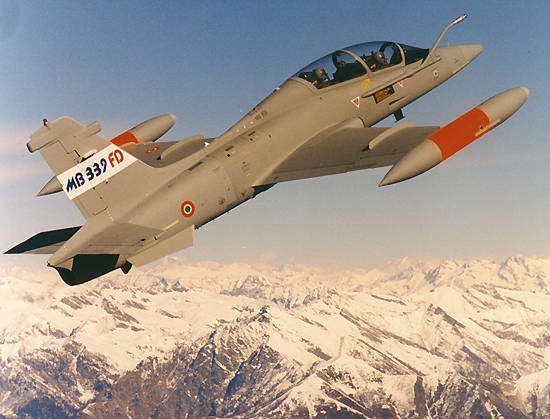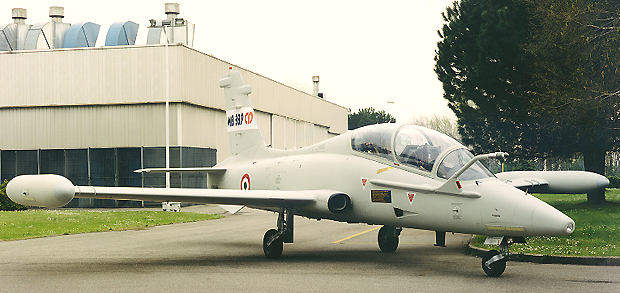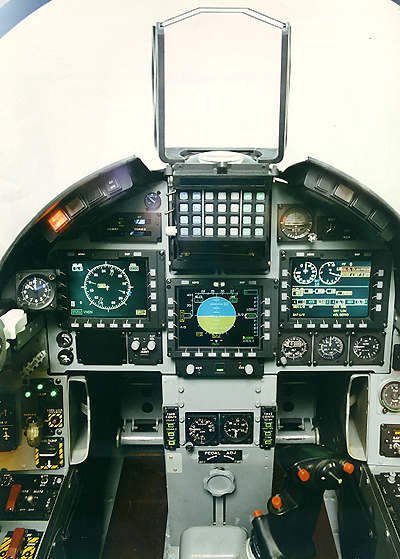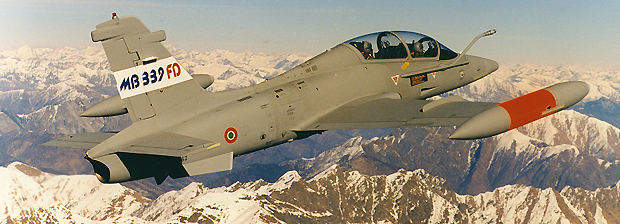The MB-339 jet trainer, produced by Alenia Aermacchi SpA of Varese, Italy, has been widely exported and is in service with the air forces of Argentina, Dubai, Eritrea, Ghana, Italy, Malaysia, New Zealand, Nigeria and Peru. The MB-339 jet trainer was initially developed to cover the basic and advanced training requirements of the Italian Air Force. Over 200 trainers are in service.
The MB-339A, equipped with a Viper 632 engine, is in service with seven air forces in basic and advanced training and close air support roles. The MB-339B is fitted with the more powerful Viper 680 Rolls-Royce engine and higher capacity tip tanks.
The MB-339C, also powered by the Viper 680 engine, is fitted with an enhanced avionics fit. The aircraft has been in full service since 1991 and its configuration includes: head-up display (HUD) in both cockpits; a monochromatic multifunction display (MFD); hands on throttle and stick (HOTAS) control; NAV computer; weapon-aiming computer; inertial platform; stores management system and radar warning receiver.
MB-339CD advanced fighter trainer
The MB-339CD advanced fighter trainer covers weapon system management in a high-performance, high-manoeuvrability aircraft, meeting the requirement for a low-cost aircraft to train Tornado crews and Eurofighter pilots. The first flight of the aircraft was in 1996.
The MB-339CD full digital trainer is equipped with a new avionics suite connected by a MIL-STD-1553B dual redundant data bus and retains the Viper 680 engine of the MB-339C. Full control and display duplication in the rear cockpit provides effective system operator training.
30 MB-339CD have been delivered to the Italian Air Force. The aircraft is representative of current generation front-line combat aircraft and it retains close commonality with the MB-339A, being equipped with the Viper 632 engine already in service.
In July 2006, Nigeria placed a contract with Alenia Aermacchi to upgrade 12 MB-339A aircraft to the MB-339CD standard.
In November 2006, the Royal Malaysian Air Force placed an order for eight MB-339CD trainers, to train pilots for fighters including the Sukhoi Su-30MKM on order for Malaysia. The first aircraft made a maiden flight in November 2009.
In October 2007, Alenia Aermacchi received a contract to upgrade 14 Italian Air Force batch 1 MB-339CD to Batch 2 configuration, which includes upgraded embedded simulation, digital maps, night-vision goggles compatibility and new AACMI (autonomous air combat manoeuvring instrumentation) pod. First flight of the upgraded aircraft was in October 2008.
Weapons
The MB-339 has the capability to carry a wide variety of US and Nato standard external stores under six wing hardpoints.
The weapons inventory includes: DEFA 30mm gun (125 rounds in each pod); anti-runway bombs; BAP-100 or BAT-120 tactical support bombs; rocket launchers for 50mm, 68mm, 81mm and 2.75in rockets; LAU-10a for US 127mm rockets or TB-100-4 launchers for French 100mm rockets; up to two Raytheon Maverick air-to-ground missiles; Matra BAe Dynamics Magic or AIM-9 Sidewinder air-to-air missiles; and Alenia MK-2A Marte air-to-ship missile.
The stores selection and delivery is controlled by a computerised stores management system (SMS) integrated into the aircraft avionic system and displayed on the multifunction display. The soft keys on the MFD’s frame are used for weapon selection parameters, which include the weapon to be used, total quantity for attack, single or double release, release interval and delivery mode.
Countermeasures
The MB-339CD is equipped with an electronic warfare suite including an Elettronica ELT-156 radar warning receiver, BAE Systems Integrated Defense Solutions (formerly Tracor) AN/ALE-40 chaff and flares dispensing system and Elettronica ELT-555 active electronic countermeasures (ECM) deception pod.
Avionics
The avionics suite is connected by a MIL-STD-1553B dual-redundant data bus. The main avionics systems are: mission processor; inertial reference system with Honeywell H-764 laser gyro platform and embedded global positioning system (GPS); radio navigation systems; air data computer; Kaiser / VDO HUDs and Sextant Avionique multifunction displays; radar altimeter; laser rangefinder; data recording and transfer system.
Mission equipment can include third-generation night-vision goggle compatibility, forward-looking infrared (FLIR) targeting pod, ACMI training system, embedded training and multiple video recording.
Rolls-Royce Viper 680 engine
The aircraft is powered by the 4,400lb thrust Rolls-Royce Viper 680 engine. The engine handles positively in all flight conditions with stall-free characteristics in all manoeuvres.
The MB-339CD has three main fuel tanks: one in the fuselage and two at the wingtips. Refuelling is through a single point pressure refuelling receptacle.















